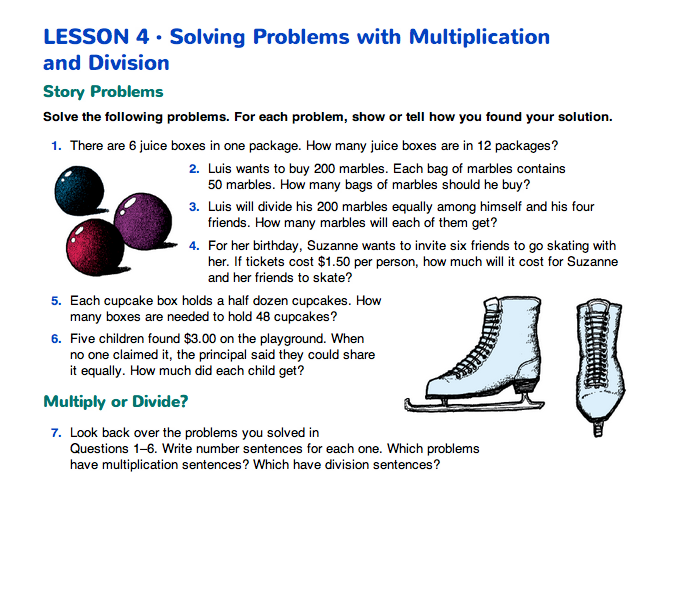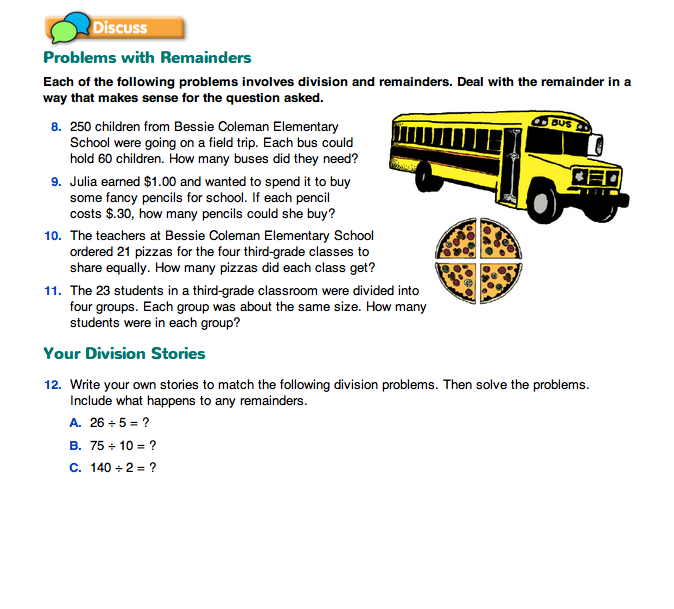Multiply or Divide. Direct students to the Solving Problems with Multiplication and Division pages in the Student Guide. Tell students that they are going to work with a partner to solve some word problems using multiplication and division. Explain that they can use any method or tool that makes sense to them to solve the problems.
- What are some strategies that might help you solve these problems? (Possible responses: You can draw a picture of the problem. You can break the problem apart and use smaller numbers. You can use number sentences. You can use repeated addition or repeated subtraction.)
- What tools can you use to help you? (Possible responses: You can use connecting cubes or base-ten pieces. You can use a calculator.)
Assign Questions 1–7 to students. As they work with their partner to solve each problem, encourage them to use multiple strategies to verify their solutions. For example, for Question 1 some students may draw a picture showing 12 rows with 6 Xs in each row for a total of 72 Xs while others might solve the number sentence 12 × 6 using doubles. See Figure 3.
Additionally, some students may choose to draw a 12 × 6 rectangle and break apart the 12 into tens and ones, or break the rectangle in half the other way.
Ask student groups to share their solution strategies with the class. As students discuss their solutions, ask them to try to use the strategies discussed to solve other problems.
- Sam and Romesh used base-ten pieces to solve Question 6. Can you use their method to find how the children would divide the money if they found $4.00?
- Can you use Sam and Romesh's strategy for Question 6 to solve Question 3?
Ask students to share the number sentences they wrote for Question 7.
Interpret Remainders. Questions 8–11 in the Student Guide are division problems with remainders. These problems involve different ways to interpret remainders: round up, round down, express as a fraction, and distribute the leftovers as equally as possible. As students solve each problem discuss the different ways remainders are interpreted.
- What division number sentence can you use to represent the problem in Question 8? (250 ÷ 60 = 4 R10)
- What does each of the numbers in this number sentence represent? (The 250 is the total number of students going on the trip. The 60 is the number of students who can go on each bus. The 4 is the number of full buses you need. The 10 is the number of students who will be left over without a bus.)
- How do you use the remainder to help you solve this problem? (Since you can't leave 10 children behind you will have to round the answer up from 4 buses to 5 buses for the trip.)
- What strategy can you use to decide how many pencils Julia could buy? (Possible response: You can use repeated subtraction. $1.00 − .30 = .70, 70¢ − 30¢ = 40¢, 40¢ − 30¢ = 10¢)
- Using this strategy, how many pencils can Julia buy? (3 pencils) How do you know? (Possible response: Each time you subtract 30¢ you bought one pencil. You subtracted 30¢ three times for three pencils.)
- How much money will be left over? (10¢)
- What should Julia do with the remainder in this problem? (Possible response: Since it is not enough money to buy another pencil, Julia should just keep it.)
- How many whole pizzas will each classroom get? (5 pizzas)
- What division number sentence can you use to represent this problem? (21 ÷ 4 = 5 R1)
- What does each number in this number sentence represent? (The 21 is the total number of pizzas. The 4 is the number of classrooms. The 5 is the number of whole pizzas for each classroom and the 1 is the leftover pizza.)
- What should be done with the one pizza that is remaining? (Possible response: Since there are 4 classrooms, the pizza can be divided in fourths and each classroom will get 51/4 pizzas.)
- What strategy can you use to divide the 23 students into 4 groups? (Possible response: You can use 23 connecting cubes and divide them into 4 equal groups.)
- Is it possible to make 4 equal groups? (No) Why or why not? (if you divide the cubes you will have 4 groups of 5 with 3 left over.)
- If all students need to be included in the groups, what should you do with 3 students who are left over? (Possible response: You can add the three students to three of the groups, so there will be three groups of six and one group of five.)
Assign Question 12 to complete independently.














